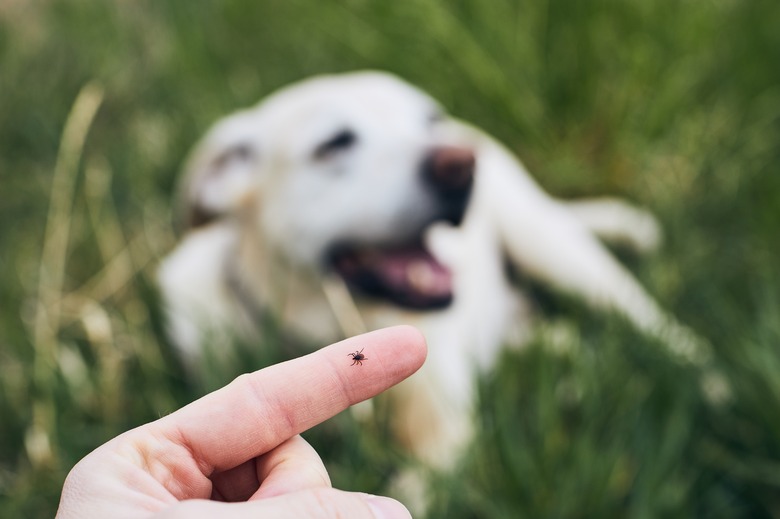Dog Skin Tag Or Tick: How To Identify And Tell The Difference
Skin growths on a dog can be either benign or malignant, and if a growth is found on a pet's skin, it's important to determine the cause. At routine wellness examinations, a veterinarian can evaluate a dog's health for symptoms of a skin condition, including dog warts, skin tumors, tick bites, or benign polyps. But if a growth suddenly appears or changes in size or appearance, it's best to get it checked out right away. Ticks can sometimes mimic skin growths like skin tags, so it's important to be able to identify these tiny bloodsuckers and remove them from your dog before they cause a problem.
What are ticks?
What are ticks?
Ticks are arachnids that feed on the blood of birds and mammals, including humans, dogs, and cats. There are many varieties of ticks, but they are typically quite small and and have eight legs as adults and six legs as larvae. Ticks are most often found in areas where there are plenty of sources from which to feed, such as woodlands and areas with tall grass where common native animals, such as deer and squirrels, tend to be. As humans or animals travel through these areas, a tick can crawl up onto them looking for nourishment.
Generally, the tick season is between March and October when the weather is warmer. Tick bites may cause swelling and itchiness, but they can be painless enough that they do not cause any immediate issues. Ticks can carry several diseases, such as Lyme disease and Rocky Mountain spotted fever. Dogs can be treated with topical or oral monthly tick preventatives to reduce the likelihood of ticks attaching to and infecting them.
What are dog skin tags?
Skin tags are a fairly common type of benign tumor. These benign growths are most common on older and larger dogs but can affect any breed at any age. Usually, they don't require treatment and are not a cause for concern. When grooming any dog, handlers should pay close attention to the dog's body to avoid pulling or tearing any skin growths.
There are times when a skin tag may need to be surgically removed, or it may be another type of growth. Signs that the growth needs veterinary attention include bleeding, discharge, a change in size or color, or multiple skin tags in a single location. Dogs may also frequently lick or scratch at the area where the skin tag is located. This is a sign that the skin tag is bothering the dog, in which case a veterinarian should be consulted to determine whether the skin tag should be removed.
Dog skin tags should never be removed by a pet parent or handler. If someone who is not properly trained removes a skin tag from a dog, it can cause complications, such as an infection, in addition to being painful for the dog. Veterinarians should always examine growths that appear to be skin tags so they can ensure that they don't need further examination or treatment.
Dog skin tag or tick?
Dog skin tag or tick?
There are a few things to look for to determine whether a growth is a dog skin tag or tick. Both skin tags and ticks can be dark brown or gray, so it can be difficult to determine what it is from sight alone. Using a magnifying glass to get a closer look can be helpful in these situations.
If a bump doesn't change in size, shape, or color and doesn't move when touched, it is more likely to be a skin tag. On the other hand, ticks will likely move when touched, and their legs may be visible when examining the dog. Ticks will become more engorged over time because their body swells as they feed on the dog's blood.
The longer a tick is attached to a dog, the more likely it is to transmit diseases to the dog. If there is ever any question or concern about whether a growth is a tick, it is crucial to get the dog to a veterinarian for an examination. The veterinarian can determine what the growth is and promptly provide the appropriate treatment if it is a tick.
Protecting a dog from the worst effects of ticks can be as simple as giving them monthly preventatives for ticks and fleas. A veterinarian can suggest the best preventative during routine checkups based on the most recent studies and the types of ticks that are in the dog's environment.
How to remove a tick from a dog
How to remove a tick from a dog
Ticks are very small and can be hard to spot, so it is important to regularly examine dogs after they have been outdoors, especially in areas where ticks are common. When inspecting a dog, think about warm areas of your dog where ticks might want to hide, such as a dog's armpits, inside their ears, and between their toes. Any tick that is found during an inspection should be removed immediately, and gloves should be worn when removing ticks.
To remove a tick, use a pair of clean tweezers or a tick removal tool, such as tick twisters, to grasp the tick close to the dog's skin and pull it straight out. The tick should be pulled out in a slow and steady fashion because if any parts are left behind, it can cause inflammation and/or infection in the dog. After the tick has been removed, dispose of the tick by dropping it into a jar of rubbing alcohol. Ticks are difficult to kill, so if it is simply placed in the trash, it could easily escape and attach to anyone in the household.
It is not uncommon for the tick to pull a bit of your dog's skin when you remove it, so don't be concerned if your dog has a bit of a scab or is itchy for a couple of days. If the site doesn't heal, if the itching doesn't go away, or if you notice other symptoms, such as lethargy, take your dog to the veterinarian for treatment.
When to see a veterinarian
When to see a veterinarian
If a dog is kept on monthly preventatives and checked routinely, it should be easy to spot and remove a tick if it attaches to the dog. However, there are still some cases in which it might be more appropriate to bring the dog to a veterinarian. It's important for pet parents to monitor the dog so testing and treatment can be provided if necessary.
After removing a tick from a dog, they may have a scab and may scratch at the area for a few days. However, if the area where the tick was attached does not heal or still seems itchy after a few days, it's a good idea to bring them to the veterinarian. Abnormal symptoms, such as lethargy, are another sign that the dog should be seen by the veterinarian.
The bottom line
The bottom line
Dog skin tags and ticks can both present as very small growths on a dog's skin. While skin tags are usually harmless, ticks can quickly infect a dog with various tick-borne illnesses. Dogs should be examined by their caretakers regularly, and any new growth should be examined by your DVM (veterinarian) carefully to determine if it is a dog skin tag or tick.



